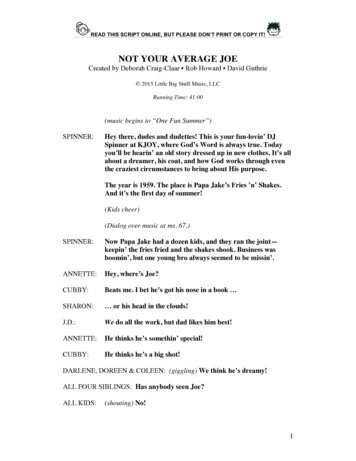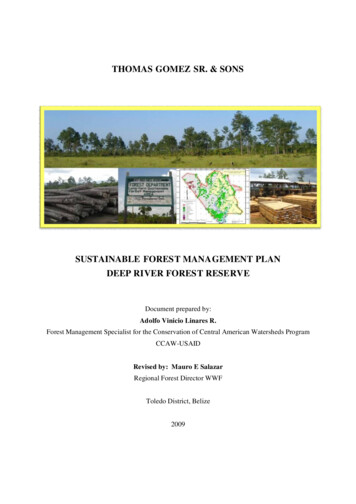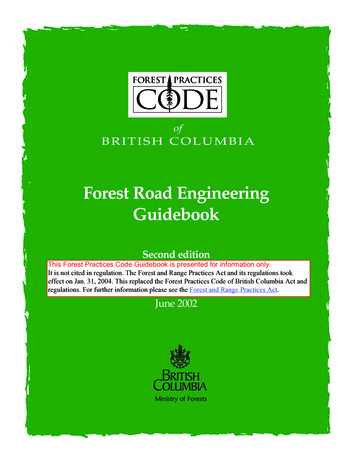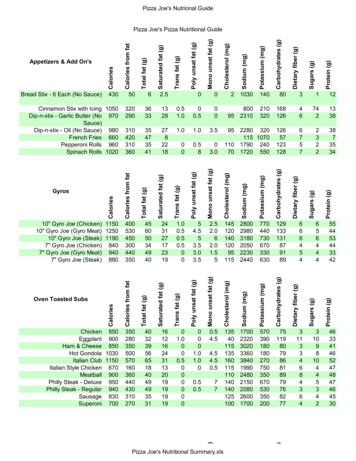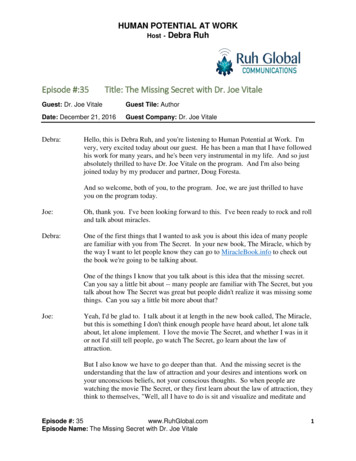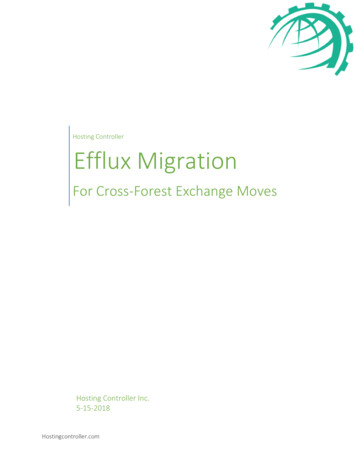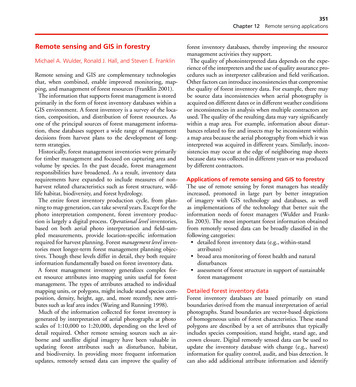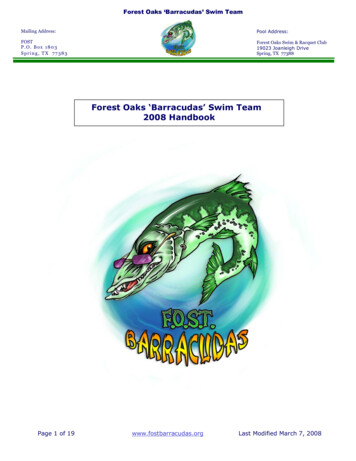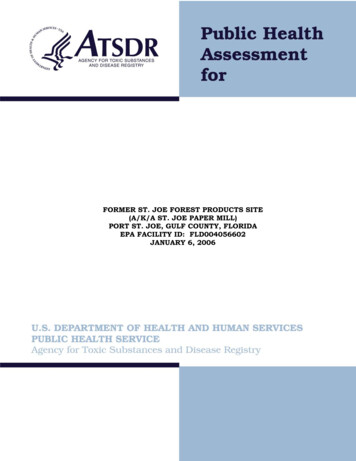
Transcription
FORMER ST. JOE FOREST PRODUCTS SITE(A/K/A ST. JOE PAPER MILL)PORT ST. JOE, GULF COUNTY, FLORIDAEPA FACILITY ID: FLD004056602JANUARY 6, 2006
THE ATSDR PUBLIC HEALTH ASSESSMENT: A NOTE OF EXPLANATIONThis Public Health Assessment was prepared by ATSDR pursuant to the Comprehensive Environmental Response, Compensation, andLiability Act (CERCLA or Superfund) section 104 (i)(6) (42 U.S.C. 9604 (i)(6)), and in accordance with our implementing regulations(42 C.F.R. Part 90). In preparing this document, ATSDR has collected relevant health data, environmental data, and community healthconcerns from the Environmental Protection Agency (EPA), state and local health and environmental agencies, the community, andpotentially responsible parties, where appropriate.In addition, this document has previously been provided to EPA and the affected states in an initial release, as required by CERCLAsection 104 (i)(6)(H) for their information and review. The revised document was released for a 30-day public comment period.Subsequent to the public comment period, ATSDR addressed all public comments and revised or appended the document as appropriate.The public health assessment has now been reissued. This concludes the public health assessment process for this site, unless additionalinformation is obtained by ATSDR which, in the agency’s opinion, indicates a need to revise or append the conclusions previouslyissued.Agency for Toxic Substances & Disease Registry. Julie L. Gerberding, M.D., M.P.H., AdministratorHoward Frumkin, M.D., Dr.P.H., DirectorDivision of Health Assessment and Consultation . . William Cibulas, Jr., Ph.D., DirectorSharon Williams-Fleetwood, Ph.D., Deputy DirectorHealth Promotion and Community Involvement Branch . Lisa Calhoun Hayes, P.E., DEE, Acting ChiefExposure Investigations and Consultation Branch. Susan M. Moore, Ph.D., ChiefFederal Facilities Assessment Branch . Sandra G. Isaacs, B.S., ChiefSuperfund and Program Assessment Branch .Richard E. Gillig, M.C.P., ChiefUse of trade names is for identification only and does not constitute endorsement by the Public Health Service or the U.S. Department ofHealth and Human Services.Additional copies of this report are available from:National Technical Information Service, Springfield, Virginia(703) 605-6000You May Contact ATSDR TOLL FREE at1-888-42ATSDRorVisit our Home Page at: http://www.atsdr.cdc.gov
Former St. Joe Forest Products SiteFinal ReleasePUBLIC HEALTH ASSESSMENTFORMER ST. JOE FOREST PRODUCTS SITE(A/K/A ST. JOE PAPER MILL)PORT ST. JOE, GULF COUNTY, FLORIDAEPA FACILITY ID: FLD004056602Prepared by:Florida Department of HealthBureau of Community Environmental HealthUnder Cooperative Agreement with theAgency for Toxic Substances and Disease Registry
Former St. Joe Forest Products site Public Health AssessmentCONTENTSForeword . iiSummary and Statement of Issues . 1Purpose. 3Background . 3Site Description and History. 3Demographics . 6Land Use . 6Natural Resource Use . 7Site Visit . 7Community Health Concerns. 8Discussion . 9Child Health Considerations . 30Conclusions. 33Recommendations. 35Public Health Action Plan. 36Authors, Technical Advisors . 37References. 38Appendix A—Figures and Photographs . 42Appendix B—Tables . 59Appendix C—Gulf County Florida Cancer Data Summary . 77APPENDIX D—Risk of Illness, Dose Response/Threshold, and Uncertainty in Public HealthAssessments . 80APPENDIX E—Public Comments and Florida DOH Responses . 82Appendix F—Glossary of Environmental Health Terms . 90
Former St. Joe Forest Products site Public Health AssessmentForewordThis document summarizes public health issues for the former St. Joe Forest Products site in PortSt. Joe, Florida. Florida Department of Health (Florida DOH) developed this report using siteevaluations prepared by contractors for the current site owners and DEP and their contractors. Anumber of steps are necessary to do such an evaluation: Evaluating exposure: Florida DOH scientists begin by reviewing available informationabout environmental conditions at the site. The first task is to find out how muchcontamination is present, where it is located, and how people might be exposed to it.Usually, Florida DOH does not collect its own environmental sampling data. We rely oninformation provided by the Florida Department of Environmental Protection (FDEP),the U.S. Environmental Protection Agency (EPA) and other government agencies, privatebusinesses, and the public. Evaluating health effects: If there is evidence that people are being exposed—or could beexposed—to hazardous substances, Florida DOH scientists determine whether thatexposure could be harmful to human health. This report focuses on public health; that is,the health effects on the community as a whole. It is based on existing scientificinformation. Developing recommendations: In the evaluation report, Florida DOH outlines itsconclusions regarding any potential health threat posed by a site. It also offersrecommendations for reducing or eliminating human exposure to contaminants. The roleof Florida DOH in dealing with hazardous waste sites is primarily advisory. For thatreason, the evaluation report will typically recommend actions EPA, FDEP, or the partyresponsible for site remediation should take. If, however, a health threat exists or isimminent, Florida DOH will issue a public health advisory warning people of the danger,and will work to resolve the problem. Soliciting community input: The evaluation process is interactive. Florida DOH starts bysoliciting and evaluating information from various government agencies, individuals ororganizations responsible for cleaning up the site, and those living in communities nearthe site. We share any conclusions about the site with the groups and organizationsproviding the information. Once an evaluation report has been prepared, Florida DOHseeks feedback from the public. If you have questions or comments about this report, weencourage you to contact us.Please write to:Health Assessment TeamBureau of Community Environmental HealthFlorida Department of Health4052 Bald Cypress Way, Bin # A-08Tallahassee, FL 32399-1712Or call us at:(850) 245-4299, or toll-free during business hours: 1-877-798-2772
Former St. Joe Forest Products site Public Health AssessmentSummary and Statement of IssuesThe former St. Joe Forest Products site is at 600 West U.S. Highway 98 on St. Joe Bay in PortSt. Joe, Gulf County, Florida. From 1938 to 1974, St. Joe Paper Company discharged millwastewater into an unlined impoundment on the northern part of the site and into St. Joe Bay.After 1974, St. Joe Paper Company conveyed its mill wastewater to the Port St. Joe wastewatertreatment plant. In 1996, St. Joe Paper Company sold the southern millworks to Florida CoastPaper. St. Joe Paper Company (now St. Joe Company) retains ownership of the northern part ofthe site.Florida Coast Paper temporarily closed the mill in 1997 and then permanently closed it in 1998due to financial difficulties. Stone Container Corporation took ownership in 2000 and laterdecided to dismantle the mill. Cleanup of the site is proceeding under Florida’s Brownfieldsredevelopment program. Stone Container Corporation and St. Joe Company have formed a jointventure to develop the property and each company agreed to assess and remediate the portion ofthe site it owns.In early 2003, Stone Container’s contractors demolished all structures on the southern part of thesite. In early 2004, their contractors completed removal of some of the contaminated soil fromthe site. This soil contained amounts of polychlorinated biphenyls (PCBs) that exceeded theFDEP Soil Cleanup Target Levels (SCTLs) for commercial or industrial land use areas.Stone Container Corporation completed remediation to commercial and industrial standards inMay 2005. Their contractors used engineering controls and institutional controls to prepare thecontaminated portions of the southern parcel for future commercial or industrial use. Engineeringcontrols included soil removal and capping. Their contractors installed a monitoring well downgradient of the area of capped soil and will continue to sample this well and other monitoringwells according to a schedule authorized by DEP in March 2005. Stone Container Corporationplans to prohibit future use of groundwater for potable or other uses through deed restrictions.Currently, access to the southern part of the site is restricted on the north, east, and southperimeters by gated chain-link fencing with “no trespassing” warning signs. The westernboundary has a seawall and the contaminated soil remaining on the site has been capped with atleast two feet of clean soil.The St. Joe Company could carry out similar remediation plans for the northern part of the site.St. Joe Company’s contractor stated “St. Joe Company does not intend to develop the subjectproperty for residential purposes and is willing to record a Declaration of Restrictive Covenantfor such property, preventing or limiting certain uses (e.g., residential) and activities (e.g.,excavation) on the site” (Professional Service Industries, Inc. [PSI] 2004). FDEP requires suchdeed restrictions to allow the use of SCTLs it has set for commercial/industrial direct exposuresor for leaching to groundwater (FDEP 1999). St. Joe Company plans additional soil testing todetermine the extent of PAH contamination in the former wastewater impoundment. Whilechain-link fencing, the Gulf County Canal, and St. Joe Bay restrict access to the northern part ofthe site, Florida DOH personnel have seen people fishing from the northern bank of the propertythat borders Gulf County Canal. People can reach this part of the site from Highway 98 or byboat. Data have not shown this part of the property has contaminated soil, but St. Joe Companyshould post their property with signs warning people to avoid contact with the soil on the interiorof site, especially where the former impoundment is located.1
Former St. Joe Forest Products site Public Health AssessmentFlorida Department of Health (Florida DOH) evaluated the available site analytical data in thecontext of Brownfields remediation. Florida DOH recommends the owners prevent the use ofgroundwater for potable or other purposes and prevent future exposures to onsite soils thatexceed the commercial and industrial SCTLs. If land use changes, and the site is used forresidential purposes, soil should be cleaned up to residential standards.It is unlikely that contaminants from the site will affect groundwater used for drinking or otherhousehold purposes in offsite areas. DEP is requiring testing of on-site wells every 6 months todemonstrate contaminated groundwater will not affect the offsite water quality. The City of PortSt. Joe supplies nearby residences with municipal water. Florida DOH asked the Gulf CountyHealth Department if there were private wells near the site. Gulf County Health Department staffdo not know of any nearby potable wells, but confirmed that a few people use shallow irrigationwells.Other off-site contamination data are insufficient for evaluation of public health threat. The fewsediment and surface water samples collected to date do not characterize chemicals in St. JoeBay or Gulf County Canal. It is unknown if contaminated groundwater is entering St. Joe Bay.Florida DOH recommends that St. Joe Company should characterize the extent of contaminationin sediments near the dock and throughout St. Joe Bay.Florida DOH also recommends that St. Joe Company collect sheepshead, redfish, spotted seatrout, hardhead catfish, flounder, and southern quahog clams from the eastern part of St. Joe Baynear the site, Gulf County Canal, and the Port St. Joe Marina. These species are eaten by localsand visitors, or are harvested commercially. They should be analyzed for dioxin/furan toxicityequivalents (TEQs) and polychlorinated biphenyls (PCBs). In addition, the flounder and southernquahog clams should be analyzed for polycyclic aromatic hydrocarbons (PAHs).Florida DOH put the Public Comment draft of the Public Health Assessment on our UND/PHA.htmin early June in anticipation of our Public Meeting on June 21, 2005. We handed out copies ofthe report to four of the people who attended the meeting to share with others who attended theirchurches. We gave copies to Gulf County Health Department staff and mailed a copy to the PortSt. Joe Public Library.Florida DOH will inform and educate nearby residents and local health care professionals aboutthe public health threats associated with this site. Florida DOH, Bureau of CommunityEnvironmental Health staff will evaluate additional test results with respect to public healthimplications as they become available.2
Former St. Joe Forest Products site Public Health AssessmentPurposeThe Florida Department of Health (Florida DOH) evaluates the public health significance ofhazardous waste sites through a cooperative agreement with the federal Agency for ToxicSubstances and Disease Registry (ATSDR) in Atlanta, Georgia. In 2002, the Florida Departmentof Environmental Protection (FDEP) asked Florida DOH to evaluate the public health threatfrom chemicals found in soil, sediments, groundwater, surface water, and seafood samples onand near the former St. Joe Forest Products site.BackgroundThe 168-acre, former St. Joe Forest Products site is at 600 West U.S. Highway 98 on St. Joe Bay,Port St. Joe, Gulf County, Florida (Figures 1 and 2). Gulf County Canal bounds the property onthe north, Highway 98 (also know as County Road 30 and Butler Bay Road) is to the east,Howards Road is to the south, and St. Joe Bay is to the west. The southern (approximately) 120acres, owned by Stone Container Corporation, includes the former mill area. A guardhouse,chain-link fences, gates, and the bay restrict access to this part of the site. Stone Containerdismantled the mill in 2003, but ship-mooring facilities still exist along the western edge of thesite. Before the demolition, security personnel guarded the southern part of the site 24 hours aday. St. Joe Company (formerly St. Joe Paper Company) owns the northern 48 acres of the site.The northern part of the site includes a buried impoundment where the St. Joe Paper Companyhad previously pumped wastewater to settle out solids before discharging it to the bay. Chainlink fences, gates, St. Joe Bay, and Gulf County Canal restrict access to the northern part of thesite. Anglers can reach the northernmost part of the site from Highway 98 or from a boat. Sampledata have not shown the shorelines of this part of the property has contaminated soil, but St. JoeCompany should post their property warning people to avoid contact with the soil on the interiorof site, especially where the former impoundment is located. St. Joe Company has not finalizedtheir plans for future site uses, but their current remediation plans only address futurecommercial or industrial uses.Site Description and HistoryThe St. Joe Paper Company began paper mill operations at this site in 1938. The original kraftpaper process involved the following steps: stripping the bark from pine logs,chipping the wood and screening the chunks,chemically separating the chips into cellulose, lignin, turpentine, and tall† oil,routing the cellulose through blower tanks, vibrating knotters, and stock washersto produce pulp, andmaking paper and paper products from the pulp.Over time, the St. Joe Paper Company added a tank farm, a second warehouse, a box plant, avehicle maintenance shop, a paint shop, a contractor shop, and a fiberglass shop (Figure 3).†Tall oil is a resinous oily liquid composed of a mixture of rosin acids and fatty acids obtained as abyproduct in the treatment of pine pulp. Companies use tall oil in soaps, emulsions, and lubricants.3
Former St. Joe Forest Products site Public Health AssessmentIn the 1950s, the mill began disposing of leftover pine bark, “lime grits,” and other waste inswampy areas east of the mill. From the 1950s to the 1980s, property owners built houses overthese wastes. Residents referred to the area as Mill View or Millville. In 1966, the mill beganbleaching some of the pulp cellulose in a four-stage bleaching plant. The mill bleached between3% and 25% of the total pulp between 1970 and 1996. Stone Container Corporation did not haverecords for the period from 1966 to 1970 (FDEP 2002). Operators routed mill-process solids thatcould not be recycled to a waste bin where they mixed the solids with sand and dirt from thelogs. St. Joe Paper Company used this material to surface forest roads and as agricultural lime(FDEP 2002). Before 1993, St. Joe Paper Company burned used solvent (methylene chloride),used oils, lacquer thinner, and xylene in the plant boiler. Other shop wastes included batteriesand waste paint.The paper mill produced 25–30 million gallons of wastewater per day (FDEP 2002). This watercontained dilute sulfuric acid. Operators treated the water with alum (aluminum sulfate) toneutralize the acidity. Between 1938 and 1974, the St. Joe Paper Company mill dischargedwastewater to an unlined surface impoundment on the northern part of the site. Although theimpoundment was designed as an infiltration basin, St. Joe Paper Company did periodicallyempty wastewater overflow from the impoundment into St. Joe Bay through a ditch. In 1960,mill consultants reported an 11-foot-thick layer of soft plant waste and organic material along thebottom of St. Joe Bay near the mill (Stone Container Corporation 2001). Figure 4 shows theimpoundment and ditch labeled on an aerial photo from October 1970. Figure 5 shows what thesame area looked like in 1999. From 1966 to 1974, the wastewater discharge included bleachwastewater. The plant reportedly bleached as much as 23% of their daily pulp production duringthat time.After 1974, St. Joe Paper Company conveyed its wastewaters via a ditch to the Port St. Joewastewater treatment plant (WWTP) ½ mile north-northeast of the site (FDEP 2002; Figure 2).The wastewater treatment plant used a secondary treatment system that included chlorination,influent screening, grit removal, and clarifiers. Next, plant operators aerated the wastewater in a70-acre unlined lagoon and then discharged treated effluent to the Gulf County canal, 2,600 feetupstream of St. Joe Bay. The U.S. Environmental Protection Agency (EPA) approved a NationalPollution Discharge Elimination System (NPDES) permit for this discharge. This NPDES permitrequires a 2.9-mile buffer zone in which people may not harvest oysters, mussels, or quahogclams. It does not restrict harvesting of crabs, scallops, shrimp, or finfish.Quarterly, facility-specific NPDES monitoring requirements currently include dioxins and furansdetermined by toxic equivalents (TEQ) (FDEP 2002). Before August 1994, the effluent wasanalyzed for only the 2,3,7,8-TCDD and 2,3,7,8-TCDF congeners. From 1974 to October 1990,dioxin/furan discharge limitations were not part of the WWTP NPDES permit.According to FDEP (2002), the Port St. Joe WWTP reported only three violations for the papermill between 1994 and 1998. On July 7, 1998, the mill discharged turpentine and failed to reporta sludge load. On August 19, 1998, the mill failed the pretreatment standard for iron (4,500micrograms per liter [µg/L]).Specific chemicals associated with paper mills include mercaptans, pinenes, limonene,methylphenols, dimethyl phenols, and chloroform. Resin acids and diterpene compounds occurnaturally in softwoods. They may break down in wastewater aeration pond anaerobic zones to analkyl-substituted phenanthrene, also known as retene. Other compounds often present in paper4
Former St. Joe Forest Products site Public Health Assessmentmill air and wastewater include volatile and semivolatile organic compounds (VOCs andSVOCs), extractable organics, and absorbable halides.A 1988 study of five paper mills (including St. Joe Paper) by the National Council of the PaperIndustry for Air and Stream Improvement, Inc. (NCASI) found that bleaching pulp with chlorineand hypochlorite produced dioxins and furans. As a follow up, St. Joe Paper participated in anEPA/Paper Industry cooperative study of 104 mills (EPA 1990). The study’s purpose was to findprocess changes that might reduce effluent dioxins and furans. These process changes includedpretreating lignin with hydrogen peroxide and using chlorine dioxide in the bleaching process.In the early 1990s, the U.S. Fish and Wildlife Service (USFWS) and St. Joe Paper Companytested St. Joe Bay sediments, fish, and shellfish for dioxins and furans with inconclusive results(see the biota sampling section). The EPA also required testing of mill wastewater as arequirement of its NPDES surface water discharge permit.In the 1990s, the FDEP identified several instances of improper waste handling at the mill. In1992, FDEP found groundwater contamination between the vehicle maintenance and fiberglassshops. FDEP granted St. Joe Paper Company “no further action” groundwater remediation statusin 1995. However, monitoring well groundwater samples analyzed in 2001 showedtrichloroethene and vinyl chloride in shallow groundwater on the southern part of the site.Florida Coast Paper (a joint venture of Stone Container Corporation and Box USA) purchasedthe mill and the southern part of the property from St. Joe Paper Company in 1996 (Appendix A,Photograph 1). The company temporarily closed the mill in 1997 and then permanently closedthe mill in 1998 due to financial difficulties. In January 2000, Stone Container acquired thesouthern half of the property following Florida Coast Paper’s bankruptcy settlement.Stone Container Corporation completed most of the remediation activities for the southernportion of the site according to DEP’s Brownfields regulations by May 2005. In 2002,contractors for Stone Container dismantled the mill and sold the building materials. Thecompany’s contractors removed 12,000 linear feet and 8,000 square-feet of friable (easily brokenapart) asbestos-containing materials. They also removed 27.65 tons of hazardous materials andbetween 465 and 1,200 gallons of oil from 12 transformers containing polychlorinated biphenyls(PCBs). They returned the radioactive sources from 30 nuclear density gauges to theirmanufacturers. They transported the remaining tall oil to Arizona Chemical, and reclaimed andshipped other remaining liquids to other paper mills. The contractor cleaned and removed allaboveground storage tanks and process-chemical storage tanks, and shipped 3,500 tons of lime toWittmer and Associates in Crestview, Florida, for agricultural use. Contractors removedsediments from the ditch that transferred wastewater from the site to the Port St. Joe WWTP andcleaned all U-drains and underground piping. Stone Container’s contractors demolished theremaining buildings with explosives in January 2003 (Appendix A photographs).FDEP approved the Brownfields Site Assessment Malcolm Pirnie prepared for the southern partof the site on April 9, 2004. Investigation activities addressed past operational practices at themill site, recommendations from FDEP, and comments from former mill staff and otherconcerned citizens. Remediation activities included the following: excavation and removal of 104 cubic yards of PCB-impacted soil ( 50 ug/kgconcentration from one location) to a landfill in Emelle Alabama,5
Former St. Joe Forest Products site Public Health Assessment excavation and removal of 846 cubic yards of PCB-impacted soil ( 50 ug/kgconcentration from five locations) to Springhill landfill in Campbellton, Florida, excavation and relocation of 222 cubic yards of PAH-impacted soil from ten locations toa location in the center of the property, where it was capped, excavation and relocation of 18 cubic yards of metals-impacted soil from two locationsto a location in the center of the property, where it was capped, development of a restrictive covenant on the property deed for the consolidation areas, installation of a monitoring well down-gradient of the consolidation areas to verify therelocated impacted soils are not leaching PAHs or metals to groundwater, sampling and analysis of piezometers and monitoring wells after the consolidationactivities were concluded (initial and confirmatory sample events), development of a restrictive covenant on the property deed for the use of groundwaterfrom the shallow aquifer.Figure 8 shows all soil excavation areas and monitoring well locations. Two areas of PAHimpacted soils, one area of PCB-impacted soil and one area of metals-impacted soil could not beexcavated because they were below the water table (Figure 9). These areas were capped with atleast three feet of clean soil. Post remedial activities will include testing groundwater every sixmonths from five wells and four piezometers, for parameters specified by DEP (Figure 8 showsthe well locations).According to FDEP Northwest District personnel, future site use may include light commercialand residential operations. The St. Joe Port Authority may also use part of the property.DemographicsIn 2000, approximately 1,060 persons lived within a mile of the center of the site. Approximately74% were black, 23% were white, about 1% were American Indian and Alaskan Native, Asian orHispanic, and about 1.5% were two or more races. Closer to the site (within ¼ mile), of 730 totalpersons counted in the 2000 census, roughly 93% were black, 5% were white, about 2% weretwo or more races, and American Indians and Alaskan Natives were 1% (U.S. Census Bureau2000, estimated using LandView 5 software).After the mill closed in 1998, approximately 15 on-site employees were responsible for fireprotection and other related duties. Between 1998 and 2004, 20 to 60 subcontractors demolishedthe buildings on the site. The Florida Brownfields Redevelopment program requires contractorcertification.Land UseLand use around the site is residential, municipal, commercial, and industrial (Figure 2). North ofGulf County Canal is Highland View subdivision. East across Highway 98 are Arizona ChemicalCompany, the Port St. Joe well field and wastewater treatment plant, Mill View subdivision, andthe Apalachicola Northern Railroad. The areas south and southwest of the site include a marinaand the businesses and homes of Port St. Joe.6
Former St. Joe Forest Products site Public Health AssessmentNatural Resource UseNatural resource uses around the site include boating, swimming, fishing, and harvestingshellfish in St. Joe Bay and the Gulf of Mexico. St. Joe Peninsula State Park is across the bayfrom the site. A dredged shipping channel from the Gulf of Mexico leads to the site, and the GulfCounty Canal north of the site connects to the Intracoastal Waterway. Because of its proximity toSt. Joe Bay and the probability of groundwater withdrawal causing saltwater intrusion, shallowgroundwater under the site and nearby areas is not a current source of drinking water.Mun
From 1938 to 1974, St. Joe Paper Company discharged mill wastewater into an unlined impoundment on the northern part of the site and into St. Joe Bay. After 1974, St. Joe Paper Company conveyed its mill wastewater to the Port St. Joe wastewater treatment plant. In 1996, St. Joe Paper Company sold the southern millworks to Florida Coast Paper. St.
